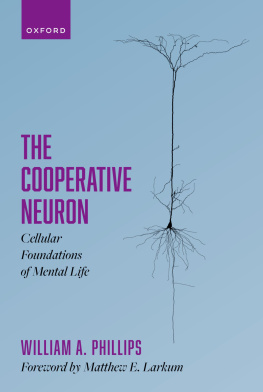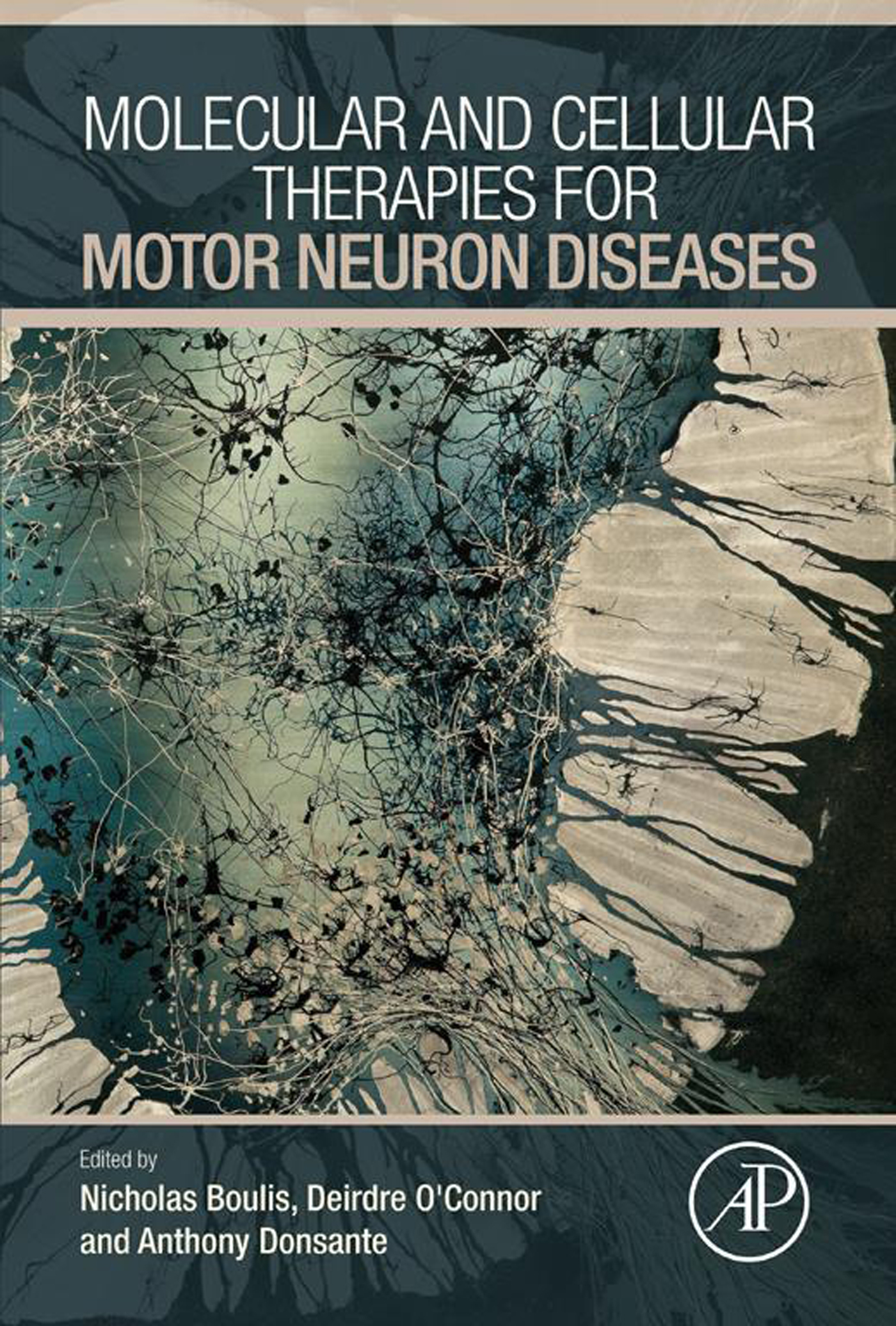Table of Contents
List of tables
- Tables in Chapter 2
- Tables in Chapter 3
- Tables in Chapter 4
- Tables in Chapter 5
- Tables in Chapter 11
- Tables in Chapter 12
List of illustrations
- Figures in Chapter 1
- Figures in Chapter 4
- Figures in Chapter 5
- Figures in Chapter 6
- Figures in Chapter 7
- Figures in Chapter 8
- Figures in Chapter 9
- Figures in Chapter 10
- Figures in Chapter 11
Landmarks
Table of Contents
Molecular and Cellular Therapies for Motor Neuron Diseases
Edited by
Nicholas Boulis
Deirdre OConnor
Anthony Donsante
Emory University, Atlanta, GA, United States

Copyright
Academic Press is an imprint of Elsevier
125 London Wall, London EC2Y 5AS, United Kingdom
525 B Street, Suite 1800, San Diego, CA 92101-4495, United States
50 Hampshire Street, 5th Floor, Cambridge, MA 02139, United States
The Boulevard, Langford Lane, Kidlington, Oxford OX5 1GB, United Kingdom
Copyright 2017 Elsevier Inc. All rights reserved.
No part of this publication may be reproduced or transmitted in any form or by any means, electronic or mechanical, including photocopying, recording, or any information storage and retrieval system, without permission in writing from the publisher. Details on how to seek permission, further information about the Publishers permissions policies and our arrangements with organizations such as the Copyright Clearance Center and the Copyright Licensing Agency, can be found at our website: www.elsevier.com/permissions.
This book and the individual contributions contained in it are protected under copyright by the Publisher (other than as may be noted herein).
Notices
Knowledge and best practice in this field are constantly changing. As new research and experience broaden our understanding, changes in research methods, professional practices, or medical treatment may become necessary.
Practitioners and researchers must always rely on their own experience and knowledge in evaluating and using any information, methods, compounds, or experiments described herein. In using such information or methods they should be mindful of their own safety and the safety of others, including parties for whom they have a professional responsibility.
To the fullest extent of the law, neither the Publisher nor the authors, contributors, or editors, assume any liability for any injury and/or damage to persons or property as a matter of products liability, negligence or otherwise, or from any use or operation of any methods, products, instructions, or ideas contained in the material herein.
British Library Cataloguing-in-Publication Data
A catalogue record for this book is available from the British Library
Library of Congress Cataloging-in-Publication Data
A catalog record for this book is available from the Library of Congress
ISBN: 978-0-12-802257-3
For Information on all Academic Press publications visit our website at https://www.elsevier.com

Publisher: Mara Conner
Acquisitions Editor: Melanie Tucker
Editorial Project Manager: Kristi Anderson
Production Project Manager: Chris Wortley
Designer: Matthew Limbert
Typeset by MPS Limited, Chennai, India
Cover image: Spinal Cord. 12K gold, ink, and dye on stainless steel panel. By Greg Dunn, 2014. www.gregadunn.com
List of Contributors
N. Boulis , Emory University, Atlanta, GA, United States
R. Bowser , St Josephs Hospital and Medical Center, Phoenix, AZ, United States
A.H.M. Burghes , The Ohio State University, Columbus, OH, United States
K.S. Chen , University of Michigan, Ann Arbor, MI, United States
M. Collins , St Josephs Hospital and Medical Center, Phoenix, AZ, United States
S. Corti
University of Milan, Milan, Italy
IRCCS Foundation Ca Granda Ospedale Maggiore Policlinico, Milan, Italy
A. Donsante , Emory University, Atlanta, GA, United States
I. Faravelli
University of Milan, Milan, Italy
IRCCS Foundation Ca Granda Ospedale Maggiore Policlinico, Milan, Italy
E.L. Feldman , University of Michigan, Ann Arbor, MI, United States
J.D. Glass , Emory University, Atlanta, GA, United States
L. Karumbaiah , The University of Georgia, Athens, GA, United States
K.P. Kenna , University of Massachusetts Medical School, Worcester, MA, United States
J.E. Landers , University of Massachusetts Medical School, Worcester, MA, United States
C.L. Lorson , University of Missouri, Columbia, MO, United States
B.J. Mader , Emory University, Atlanta, GA, United States
M.J. Magnussen , Emory University, Atlanta, GA, United States
A. McDonough , Emory University, Atlanta, GA, United States
V.L. McGovern , The Ohio State University, Columbus, OH, United States
M.R. Miller , University of Missouri, Columbia, MO, United States
D.M. O'Connor , Emory University, Atlanta, GA, United States
E.Y. Osman , University of Missouri, Columbia, MO, United States
S.L. Stice , The University of Georgia, Athens, GA, United States
R.L. Swetenburg , The University of Georgia, Athens, GA, United States
N. Ticozzi
IRCCS Istituto Auxologico Italiano, Milan, Italy
Dino Ferrari Center Universit degli Studi di Milano, Milan, Italy
L. Urquia , Emory University, Atlanta, GA, United States
Acknowledgment
This book is dedicated to the people diagnosed with this disease and their families, who have refused to take no for an answer and have dedicated themselves to raising funding for research and volunteering for risky groundbreaking clinical trials, including Josh Thompson and his family, Ed Tesoro, Ted Harada, and Christina Clark.
Chapter 1
Molecular and Extracellular Cues in Motor Neuron Specification and Differentiation
R.L. Swetenburg, S.L. Stice and L. Karumbaiah, The University of Georgia, Athens, GA, United States
Abstract
Motor neurons (MNs) are a diverse group of cells without which life would not be possible. MNs are responsible for integrating signals from the brain and the sensory systems to control all voluntary and involuntary movement, along with parts of the autonomic nervous system. Here, we focus on the specification and maturation of spinal MNs as they are a key target of disease and injury, as well as regenerative efforts. MNs arise from progenitors in the ventral neural tube and migrate into columns and pools. Notably, these progenitors later generate oligodendrocyte precursor cells. MN axons then travel outside of the central nervous system to reach their targets under guidance cues from the extracellular matrix. These cells are targets of devastating diseases including amyotrophic lateral sclerosis, spinal muscular atrophy, multiple sclerosis, as well as spinal cord injuries. By decoding the major events and players in development, we can better recapitulate them in vitro for cell replacement therapy, or harness the underlying principles for regeneration in the adult.











